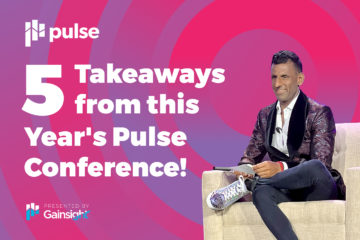
In Austin Powers, one of my favorite all-time scenes is where one of the evil henchman sees Austin in a steamroller coming toward him very slowly and yet still can’t get out of the way to avoid being… steamrolled.
Amazon, in general, and specifically in their Amazon Web Services (AWS) cloud strategy, is the steamroller inching toward paralyzed IT incumbent vendors. And Jeff Bezos, Fortune’s businessperson of the year, is driving the truck.
The AWS team kept moving the truck forward at their first user conference, re: Invent, this week in Las Vegas. Here are some quick thoughts from what I saw:
- Amazon is debunking the Innovator’s Dilemma. Clayton Christensen’s famous book talks about the repeated pattern of big companies ignoring new, less profitable markets to instead focus on existing, high margin markets. As such, they miss out on new markets and eventually get disrupted by… innovators. Well, Jeff Bezos and his team seem to have something to say about that. First of all, one of their core mantras that they repeated constantly throughout the show is that they are focused on low margins. Most vendors in technology have no idea how to make money with low margins, hence this is a huge differentiator. As such, Amazon has been able to enter new markets like cloud computing that scared away the big incumbents. And their fearlessness about margins means they continue to innovate. Just in this show, they announced a 24%+ price drop in S3 storage pricing and a data warehousing service (see below) that commoditizes the market. As Jeff Bezos has famously said before, in regard to his competition, “your margin is my opportunity.”
- Amazon is taking off the gloves. A friend of mine and I were discussing at the show how Amazon has entered the vendor conference game in the opposite way to nearly every tech vendor in history. Most vendors use conferences to trumpet the future and therefore often lack substance. AWS had an abundance of substance (a trillion objects in S3, anyone?) before it even thought about hosting an event. As such, this was a rare first conference. The normally-reticent AWS team finally talked to the world and had so much to say. All of the executives on stage, especially SVP of AWS Andy Jassy and CTO Werner Vogels, were bubbling with confidence, energy and proof points. And they weren’t afraid to take shots at the “cloud washers” trying to jump on the cloud computing bandwagon by relabeling older technologies. Check out TechCrunch’s Alex Williams’ interview of Andy Jassy for more insights.
- The customer first thing is real. So many companies list “customer first” or “customer-focused” as part of their core values (and then practice the opposite), so it’s easy to get cynical. And yet, in every interaction I’ve had with the AWS team, everyone is consistent. They learn from competitors a bit and are interested in the industry at large, but are much more concerned about what customers have to say. Even over drinks or off the record, no one veers from the message. Whether it’s Bill Bellicheck-like message training or genuine customer care (I think the latter), the team is totally in lock step.
- Not just IaaS anymore. Amazon announced RedShift, a new data warehousing service. While very cool in its own right (claiming to offer enterprise-grade data warehousing at a fraction of the cost of traditional solutions like Teradata), the move also represents a big shift for Amazon. Historically, most services have been targeted at developers and have been focused on infrastructure. Even Amazon’s Hadoop service (Elastic MapReduce) was pretty low-level in its interfaces and required strong technical knowledge. RedShift is a real enterprise application that replaces solutions customers pay millions of dollars for. How far up the stack will Amazon go?
- Amazon moves fast. Andy Jassy showed a 2012 calendar and highlighted the days Amazon introduced new services. There were little dots everywhere. And in addition to RedShift and the S3 price drops, Amazon introduced two new huge EC2 instances – one with 240 GB of RAM and another with 48 TB of disk. Honestly, I don’t know how most traditional vendors will keep up with them.
- It’s all about EBS. For large-scale applications, especially enterprise apps that heavily use databases, one of the bigger challenges for AWS users has been the Elastic Block Store (EBS) service. EBS filled a critical hole in the AWS portfolio by offering block storage that stayed around whether or not EC2 instances were on. But as customers started to tax EBS, they found they couldn’t get the consistency of IO performance (IOPS = input output operations per second) that they expected from traditional storage systems. Enter Provisioned IOPS (or pIOPS for the cool ones amongst you). Amazon introduced pIOPS back in July but customers are just starting to get their arms around it now – and they are excited. During a packed EBS session, when an AWS product manager demoed getting 20,000 IOPS consistently across 10 machines, the audience spontaneously applauded. Pretty cool.
- DynamoDB. Amazon’s noSQL database, DynamoDB, is also getting a lot of traction with AWS customers. One really cool app, WeatherBug, tracks lightning strikes across the world and alerts users to nearby lightning strikes. The developer showed how easy it was for him to scale his app with DynamoDB.
- Data Pipeline. Amazon also introduced Data Pipeline, a new service to orchestrate data movement between various Amazon repositories like S3 and EMR. This also touched on another emerging element of Amazon’s strategy – using the huge amount of data AWS stores as an advantage and allowing customers to easily move the data between various optimized repositories for various use cases.
- Using multiple Availability Zones Regions. With recent AWS outages, Amazon received some negative publicity about the reliability of its cloud. Amazon’s response is, while it’s working on reliability overall, the best practice is to use the redundancy features built into AWS like Availability Zones and Regions. Customers seem to be getting the message.
- Glacier. As a storage guy, I was pretty amazed by Amazon’s long-term archival service announced a few months ago, Glacier. At $0.01/GB/month, Glacier is probably the cheapest long-term storage option out there for most IT organizations. The AWS team talked about Glacier a lot and customers seemed to be adding it to their architectural plans.
Lots of information to absorb. But for me, the biggest message was simple: don’t get steamrolled.



